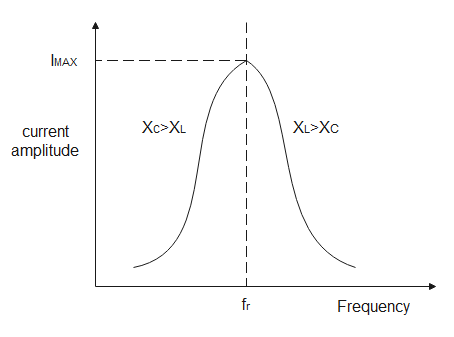
In a series RLC circuit that is operating above the resonant frequency, the current
A. lags the applied voltage
B. leads the applied voltage
C. is in phase with the applied voltage
D. is zero
Answer
555.3k+ views
Hint: At resonance the capacitive reactance and inductive reactance is equal. At above the resonant frequency the inductive reactance will be greater than the capacitive reactance. So a RLC circuit operating above resonant frequency behaves as a purely inductive circuit. The phase difference between the current and voltage will be the same in this circuit as the inductive circuit.
Formulas used:
${X_C} = \dfrac{1}{{\omega C}}$
${X_L} = \omega L$
${X_L} = {X_C}$
Complete answer:
For a circuit containing resistor, capacitor, and inductor
The inductive reactance is given by ${X_L} = \omega L$
Where $\omega = {\text{ frequency}}$ , $L = {\text{inductance}}$.
And the capacitive reactance is given by ${X_C} = \dfrac{1}{{\omega C}}$.
Current flowing through LCR circuit is given by
$\eqalign{
& V = IZ \cr
& Z = \sqrt {{{\left( {{X_L} - {X_C}} \right)}^2} + {R^2}} \cr} $
Where Z is impedance. At resonance Z will be equal to R only.
We know that inductive circuit current lags voltage and in capacitive circuit current leads voltage.
If we draw plot of current passing through LCR circuit VS input frequency it will exactly look like the below diagram

When capacitive reactance equals inductive reactance then that condition is called resonance.
At resonance
$\eqalign{
& {X_L} = {X_C} \cr
& \Rightarrow \omega L = \dfrac{1}{{\omega C}} \cr
& \Rightarrow {\omega ^2} = \dfrac{1}{{LC}} \cr
& \Rightarrow \omega = \dfrac{1}{{\sqrt {LC} }} \cr
& \Rightarrow 2\pi {f_r} = \dfrac{1}{{\sqrt {LC} }} \cr
& \therefore {f_r} = \dfrac{1}{{2\pi \sqrt {LC} }} \cr} $
Where ${f_r}$ is resonating frequency.
In the region where operating frequency is greater than resonating frequency, as per the diagram
${X_L} > {X_C}$. That means the inductor is dominating. So current lags the applied voltage.
Hence option A is correct.
Note:
If we clearly observe the above diagram, at resonating frequency current flowing is maximum because impedance which is resultant of capacitive reactance and inductive reactance and resistance is minimum there. When impedance is minimum, the current flowing will be maximum. Voltage across resistors is always in phase with current. So we are never concerned about the phase difference between the resistor voltage and its current.
Formulas used:
${X_C} = \dfrac{1}{{\omega C}}$
${X_L} = \omega L$
${X_L} = {X_C}$
Complete answer:
For a circuit containing resistor, capacitor, and inductor
The inductive reactance is given by ${X_L} = \omega L$
Where $\omega = {\text{ frequency}}$ , $L = {\text{inductance}}$.
And the capacitive reactance is given by ${X_C} = \dfrac{1}{{\omega C}}$.
Current flowing through LCR circuit is given by
$\eqalign{
& V = IZ \cr
& Z = \sqrt {{{\left( {{X_L} - {X_C}} \right)}^2} + {R^2}} \cr} $
Where Z is impedance. At resonance Z will be equal to R only.
We know that inductive circuit current lags voltage and in capacitive circuit current leads voltage.
If we draw plot of current passing through LCR circuit VS input frequency it will exactly look like the below diagram

When capacitive reactance equals inductive reactance then that condition is called resonance.
At resonance
$\eqalign{
& {X_L} = {X_C} \cr
& \Rightarrow \omega L = \dfrac{1}{{\omega C}} \cr
& \Rightarrow {\omega ^2} = \dfrac{1}{{LC}} \cr
& \Rightarrow \omega = \dfrac{1}{{\sqrt {LC} }} \cr
& \Rightarrow 2\pi {f_r} = \dfrac{1}{{\sqrt {LC} }} \cr
& \therefore {f_r} = \dfrac{1}{{2\pi \sqrt {LC} }} \cr} $
Where ${f_r}$ is resonating frequency.
In the region where operating frequency is greater than resonating frequency, as per the diagram
${X_L} > {X_C}$. That means the inductor is dominating. So current lags the applied voltage.
Hence option A is correct.
Note:
If we clearly observe the above diagram, at resonating frequency current flowing is maximum because impedance which is resultant of capacitive reactance and inductive reactance and resistance is minimum there. When impedance is minimum, the current flowing will be maximum. Voltage across resistors is always in phase with current. So we are never concerned about the phase difference between the resistor voltage and its current.
Recently Updated Pages
A man running at a speed 5 ms is viewed in the side class 12 physics CBSE

The number of solutions in x in 02pi for which sqrt class 12 maths CBSE

State and explain Hardy Weinbergs Principle class 12 biology CBSE

Write any two methods of preparation of phenol Give class 12 chemistry CBSE

Which of the following statements is wrong a Amnion class 12 biology CBSE

Differentiate between action potential and resting class 12 biology CBSE

Trending doubts
What are the major means of transport Explain each class 12 social science CBSE

Which are the Top 10 Largest Countries of the World?

Draw a labelled sketch of the human eye class 12 physics CBSE

Explain sex determination in humans with line diag class 12 biology CBSE

Explain sex determination in humans with the help of class 12 biology CBSE

Differentiate between homogeneous and heterogeneous class 12 chemistry CBSE




